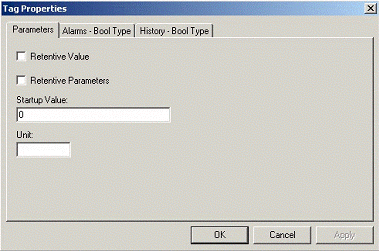Each tag type has the following properties:
- Parameters
- Alarms Properties
- History Properties
To configure these properties for a tag, click Properties on the Home tab of the ribbon. A Tag Properties dialog displays, similiar to the following:
Figure 1. Tag
Properties dialog for Boolean tag


Use the parameters on this dialog to configure the different tag properties. Instructions for configuring each type of tag follows.
String-Type Tag Parameters
From the Tag
Properties dialog, specify string-type parameter properties
as follows:
- Retentive Value checkbox: Click (check) to save the tag value continuously in case the system unexpectedly shuts down, so that it restarts from the last saved value.
- Retentive
Parameters checkbox: Click (check) to save runtime changes
in the tag's properties. Only certain properties can be saved; for
a complete list of which can and cannot, see
List of Tag Properties.
CAUTION:Enabling either of the Retentive options for tags that frequently change values can cause heavy disk access, which slows performance.
- Startup Value field: Type a tag value for the system load. The tag assumes this value if you disable the Retentive Value option.
- Unit field: Type any string (up to 9 characters) as a brief description or reference. This tag is accessible during runtime.
Note:
IWS will not accept
writing values that fall outside the ranges defined in the
Min and Max fields. In addition, IWS generates a message in the
Output window to indicate
that the system tried to write a value outside the defined
range.
Integer and Real-Type Tag Parameters
Note: For
descriptions of the Retentive
Value, Retentive
Parameters, Startup Value,
and Unit parameters, see
String-Type Tag Parameters
above.
From the Tag
Properties dialog, specify integer and real-type parameter
properties as follows:
- Engineering Units area
- Min field: Specify a minimum value for the tag in engineering units. This tag is accessible during runtime.
- Max field: Specify maximum value for the tag in engineering units. This tag is accessible during runtime.
- Unit field: Type any string (up to 9 characters) as a brief description or reference of the tag. This tag is accessible during runtime.
- Signal Conditioning area
- Dead Band checkbox: Click (check) to insert the dead band value of a tag. Dead band value is a variation around a central value of the tag, which is not recognized for alarms.
- Smoothing checkbox: Click (check) to reduce the rate of change for the tag's values. Use only for integers and real tags. For example, if you select the Smoothing option for the LEVEL1 tag containing the value = 50. Then in the next search, if the LEVEL1 changes to 60, the system will store the average of 50 + 60 in the database, so the new value = 55.
Boolean-Type Tag Parameters
Note: For
descriptions of these parameters, see String-Type Tag Parameters
above.
See also: Using Tag Properties: Alarms, Using Tag Properties: History